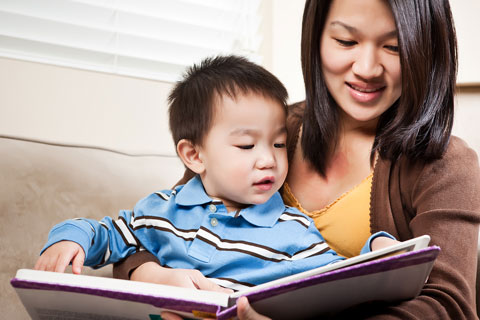When we make predictions, we form ideas about the future based on what we already know or believe. A predictable book is one that features patterns, sequences, and connections in the illustrations or words that enable children to guess “what comes next” in the story. Predictable books can be used to help 2-, 3-, and 4-year-olds learn what to expect from spoken and written language. (See Illinois Early Learning and Development Benchmarks 1.B.ECb, 2.A.ECa, 2.B.ECa, 2.C.ECa, and 10.C.ECa.)

Choose a variety of predictable books to share with very young children (ages 2 through 4).
- Picture books with basic vocabulary and simple rhyme patterns let children anticipate what word comes next. Examples: One Fish, Two Fish, Red Fish, Blue Fish by Dr. Seuss; Rap A Tap Tap by Leo and Dianne Dillon.
- Children often like to repeat simple phrases or refrains with a reader.
- Many preschoolers like stories that build on patterns. Examples: Drummer Hoff by Barbara Emberley; Bringing the Rain to Kapiti Plain by Verna Aardema.
Use children’s favorite books again and again.
- Young children may want to hear the same poem or book many times. Soon they get to know the word patterns. They may enjoy saying the words along with you.
- Many children like to fill in the blank when you leave out a word or two at the end of a sentence. Pause in your reading: “One fish, two fish, red ___.” Look around at the children. Wait for them to call out, “Fish, blue fish!”
- Some children will enjoy catching your “mistakes” when you playfully change a few words in a familiar book: “One fish, two cats, red fish….”
Expand on children’s predictions.
- Children can make up dialogue between characters in wordless and nearly wordless books. You might say, for example, “There are no words to tell us what is going on in this picture. What do you think this boy might say to the dog?”
- Children who know a book well can discuss different versions of the same story. For instance, you might read aloud from There Was an Old Lady Who Swallowed a Fly by Simms Taback. Then show the children Alison Jackson’s I Know an Old Lady Who Swallowed a Pie. Help them predict some possible similarities and differences between the two. “The lady who swallowed a fly also swallowed a spider and other animals. What do you suppose this pie-swallowing lady might eat?” Follow up by asking, “What makes you think so?”


 Printer-friendly PDF
Printer-friendly PDF PDF para imprimir
PDF para imprimir